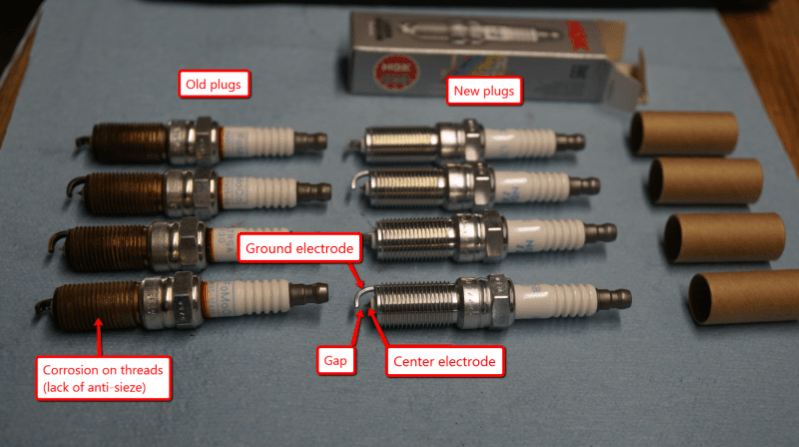Here’s How To Do A Tune-Up On A Modern Gasoline Car
By Peter Monshizadeh
Have you ever come across an ad for a used modern car that mentions the vehicle had just received a tune-up? What does “tune-up” even mean in regards to today’s cars? Well, in all likeliness, the seller of the vehicle in said advertisement doesn’t know what they are talking about. They probably just buzzword-bombed the ad to catch the attention of an unsuspecting buyer. However, I am here to tell you that there is such a thing as a modern car tune-up.
Most cars today hardly require any sort of scheduled maintenance aside from fluid changes because of the technological advancements made in the auto industry since the late 1980s. The widespread application of fuel injection and electronic, coil-on-plug ignition systems have made for engines that keep chugging along without much effort put forth by the owner.
Even still, modern cars can benefit from a tune-up every once in a while. I’m going to show you exactly what this process entails for a contemporary gasoline-powered car. Heck, you might be surprised how easy, and inexpensive, the process really is.
Spark Plug Replacement
The first item on the tune-up checklist is to replace the engine’s spark plugs. Cars today come fitted with long-life platinum or iridium-tipped spark plugs that work well for so long that it’s easy to forget they eventually wear out. These plugs often have a service life anywhere between 60,000 to 100,000 miles, which is impressive considering the extreme conditions they are put through. Some symptoms of spark plug degradation are difficult starts and slight engine power loss.
The vehicle I’m demonstrating with is a 2010 Mazda 3, which calls for a spark plug replacement at around 65,000 miles. Because the car seemed to run well, that service interval was blown right on past. The original plugs had 83,000 miles on them – it was definitely time to change them out.
Accessing the spark plugs on some cars can be a real pain, so be sure to research the procedure for your vehicle before deciding to dive in. On this Mazda, getting to the plugs required disconnecting the car’s battery, removing a plastic engine cover, and unbolting the coil packs that sit atop the spark plugs. I always recommend thoroughly cleaning the work area – especially in the spark plug holes – before removing the spark plugs. If you have access to compressed air or a Shop-Vac, use it! You don’t want dirt getting into the engine.
Removing old spark plugs can sometimes be a bit of challenge because anti-seize compound isn’t applied to the plug threads at the factory. Often the initial turn of the old plug takes some muscle, but unscrewing it should become easier as it starts to back out from the cylinder head.

With the old plugs removed, it’s time to prepare the new ones to go in. You should always check the plug gap on new spark plugs before putting them into the engine. The gap determines the temperature and intensity of the spark that the plug provides. An improperly-gapped plug can cause pre-ignition, detonation or other engine running problems. Even though plugs are usually pre-gapped for your vehicle at the factory, it’s a good practice to double-check them.

Verifying the gap can be done with an inexpensive gauge like the one pictured. The specs for your vehicle’s plug gap can be found in the owner’s manual or on a placard in the engine bay. If you find that a plug is out of spec, you can carefully adjust the gap by moving the ground electrode in or out. Platinum and iridium-tipped plugs have fragile center electrodes which can easily be ruined if a clumsy re-gap is attempted. More than likely, the plugs will check out fine without the need to be re-gapped. Once you have checked the gaps, it’s time to put the plugs into the engine.
like to apply small amount of anti-seize compound to the plug threads before installation, making sure not to get any compound on or near the plug’s center electrode. It’s a debated topic whether or not one should apply anti-seize to spark plugs.
The main arguments against it are over-tightening the plugs (anti-seize lubricates the threads and can alter the torque reading) and poor grounding against the engine’s cylinder head (anti-seize can serve as an electrical insulator). I have not encountered either of these issues when applying anti-seize. The way I see it, if there’s a product that guarantees a spark plug will never become seized in the cylinder head, then I’m going to use it. I’ll leave the anti-seize decision up to you!
With the plugs screwed in by hand, grab a torque wrench and tighten them to specification. The spark plug torque specification for your vehicle can easily be found online through a Google search. Don’t have a torque wrench? Get one. An adequate wrench can be picked up for around $10 at discount tool stores. With the plugs properly torqued, you can refit the coil packs and the engine cover, but leave the battery disconnected to perform the subsequent tune-up steps.
Throttle Body Cleaning
The next item on the tune-up list is to clean out the throttle body. The throttle body is what controls the engine speed on a gasoline engine. There is a flap inside of it that swings open and closed based on how much gas you give the throttle pedal. Over time, a significant amount of carbon buildup can form on the backside of this flap, which is mainly caused by the engine’s PCV (Positive Crankcase Ventilation) system. This buildup can cause a rough engine idle and a sluggish throttle response, among other symptoms.
While cleaning the throttle body doesn’t usually get listed on your vehicle’s scheduled maintenance plan, it really is something that should be done. If your car has over 50,000 miles and you don’t know if it has been cleaned, it probably needs it.
The materials required for this job are a can of throttle body cleaner, a new throttle body gasket, and some shop towels. In order to do a thorough job of cleaning, you will need to remove the throttle body from the vehicle. This will necessitate removing the rubber intake plumbing, popping off some electrical connectors, and unscrewing a few bolts that hold the throttle body to the engine’s intake manifold. Depending on the vehicle, you may also have to slip off a couple of coolant hoses that enter and exit the throttle body.
That’s the kind of buildup you can expect to find.
With the throttle body out of the vehicle, you will probably see a thick coating of carbon on the side that faces the intake manifold. Your objective is to remove all of that gunk. If there are electrical components on your throttle body, such as an actuator motor like on this Mazda’s throttle body, you don’t want to just shoot the cleaner into the throttle body. Instead, spray the cleaner on a shop towel and begin wiping off the buildup. It may take a little more time to do it this way, but it’s better than taking the risk of ruining expensive electrical components.
Slowly removing all of the gunk.
CAUTION: Make sure you’re in a well-ventilated area when using throttle body cleaner – it’s potent. Wearing eye protection and rubber gloves is a good idea too.
With all of the buildup removed, it’s time to remount the throttle body to the intake manifold using a new throttle body gasket. It’s important to use a new gasket upon re-installation as the gasket can only be compressed once to guarantee an air-tight seal.
COST: $15
MAF or MAP Sensor Cleaning
If your car is fuel injected, it will be fitted with either a MAF or MAP sensor. The MAF (Mass Air Flow) sensor, or alternatively, the MAP (Manifold Absolute Pressure) sensor, tells your car’s computer how much air is flowing into the engine. This information is used to determine how much fuel should be injected into the cylinders, among other critical metrics that optimize engine performance.
Both sensor types can become dirty over time which can result in numerous engine ailments. Some common symptoms are reduced fuel economy, hard starts, and jerky acceleration. Luckily, cleaning these sensors is about as easy as DIY mechanical work gets.
The Mazda 3 is fitted with a MAF (as opposed to a MAP) sensor, so that is what I am going to demonstrate how to clean. The only material you will need to clean a sensor like this is some Mass Air Flow sensor cleaner spray which can be picked up at any auto parts store. It is important to note that there are various types of MAF sensors – not all of them are like the one in these photos.
CAUTION: Be sure to research how to best clean your particular MAF or MAP sensor before proceeding. Special precautions and/or cleaning products may be required to avoid damaging the specific type of sensor your vehicle uses.
The MAF sensor on this car is located in an easily accessible spot right near the air box. Unclipping an electrical connector and removing two small screws is all that it takes to pull the sensor out of the car.
There are two parts that will need to be cleaned on this kind of MAF sensor: The temperature sensor and the wire elements. You can see that the temperature sensor has dark discoloration on one side of it. The wire elements, which are difficult to see because they are nested deep within the sensor, can also be contaminated with foreign particulates. With these components identified, we can direct the MAF cleaner spray nozzle directly at them. With a spritz of cleaner, the components will clean up like new.
Once the cleaner spray has fully dried, the sensor will be spotless once again. That’s all it takes to clean a MAF sensor like the one on this Mazda. Reinstall it back into the car, reconnect the car’s battery (You disconnected it when replacing the spark plugs, remember?) and embrace that warm sense of accomplishment!
Cost: $10
Air Filter Replacement
Alright, so I’m sure this one seems like a no-brainer, but you’d be surprised how often this gets overlooked. Your car’s engine air filter can be both a life saver and a curse. When working to its optimal ability, the air filter keeps dirt and other particulates from getting into your engine. However, after 15,000-30,000 miles (depending on the vehicle and driving conditions), that air filter will become clogged and no longer allow an adequate amount of air to get through. At this point the filter is effectively suffocating your engine.
A good quality air filter can be picked up for a reasonable price at your local auto parts store. For a lot of vehicles, getting to the air filter doesn’t even require tools. Many manufacturers make them easy to access and to replace.
With the old air filter removed, you may find that a lot of debris has collected inside of the air box. I recommend either removing the air box so you can dump it out, or just grab a Shop-Vac and vacuum it all away. Once that is taken care of, slip in the new air filter and your engine will be breathing freely once again.
COST: $20
Feeling Refreshed
An argument could be made that there are a tremendous number other consumable parts, such as PCV valves, spark plug wires, ignition caps, oxygen sensors, and fuel filters, which are also due for replacement during a tune-up on a modern car. However, these other parts have lifespans that vary widely from vehicle to vehicle. Not to mention, some cars aren’t even fitted with a few of those parts to begin with.
The above list represents an inexpensive, DIY-friendly set of tasks that can be accomplished in an afternoon. These procedures can be applied to nearly every gasoline vehicle on the road today. When it comes to contemporary vehicles, routine maintenance has never been easier. Even still, you have to give that modern driver the occasional tune-up so it can keep running at its best.



























